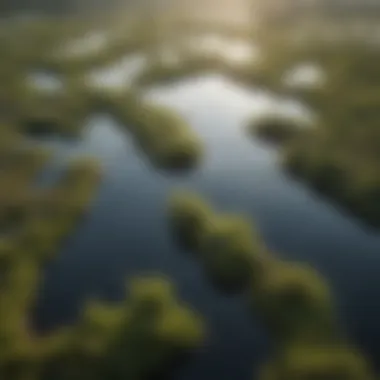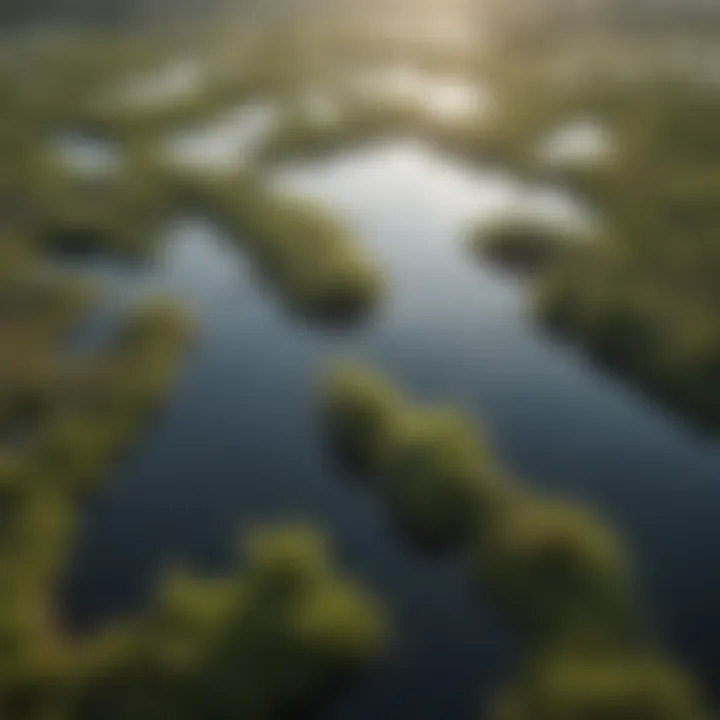Wetlands: Crucial Players in Climate Dynamics


Intro
Wetlands are more than just muddy bodies of water; they are dynamic ecosystems that act as crucial regulators of our climate. These areas, characterized by the presence of water—either permanently or seasonally—support a rich diversity of plant and animal life. In recent years, the realities of climate change have become increasingly apparent, raising questions about how these valuable systems interact with shifting environmental conditions. As the climate continues to change, the resilience of wetlands is being tested. Their ability to mitigate climate impacts, including flooding and carbon sequestration, is becoming more significant than ever.
Research Overview
Summary of Key Findings
Recent studies have demonstrated the pivotal role wetlands play in climate regulation. They serve as carbon sinks, absorbing carbon dioxide from the atmosphere and storing it in plants and soil. According to the Intergovernmental Panel on Climate Change, wetlands are responsible for capturing a significant percentage of global carbon emissions. Furthermore, the diverse biodiversity housed within these ecosystems plays a vital role in maintaining ecological balance and promoting resilience against climate fluctuations.
Conversely, the effects of climate change are starting to show their teeth, impacting wetland ecosystems in profound ways. Rising sea levels, increased salinity, and altered rainfall can lead to habitat loss, reduced biodiversity, and disrupted ecological functions. The stakes are high.
Background and Context
Historically, wetlands have been undervalued and often seen as wastelands. However, decades of research indicate they are perhaps one of the most vital ecosystems on the planet. Definitions of what constitutes a wetland vary from country to country, but they typically include marshes, swamps, fens, and bogs. Human activities like urban development, agriculture, and pollution have significantly contributed to wetland degradation, further exacerbating the vulnerabilities these ecosystems face.
As rising temperatures and extreme weather conditions alter the landscape, understanding the transformations occurring in wetland regions is paramount. This article will dig into these themes, leveraging recent research to underscore the necessity for wetland conservation in the face of age-old challenges.
"Wetlands are essential for maintaining the health of our planet, yet they remain some of the most threatened ecosystems on Earth."
Methodology
Experimental Design
To articulate the relationship between wetlands and climate change succinctly, a combination of experimental methodologies is used. This involves both quantitative and qualitative approaches to assess wetland functions and their responses to changing climatic conditions. Field studies, remote sensing technologies, and laboratory analyses provide a multi-faceted picture of ecosystem dynamics.
Data Collection Techniques
Data collection employs a variety of techniques:
- Field Surveys: Gathering empirical data on wetland health and flora/fauna diversity.
- Remote Sensing: Utilizing satellite imagery and aerial photography to monitor changes in wetland areas over time.
- Climate Modeling: Simulations help predict future scenarios based on existing trends.
- Community Engagement: Local knowledge and experiences are crucial for understanding the impacts of climate change on wetlands.
Through these methodologies, the intricate dialogue between wetlands and our changing climate can be elucidated, paving the way for informed conservation strategies.
Understanding Wetlands
Wetlands are unique ecosystems that serve critical roles in our environment and are essential in the context of climate change. As we delve into their complexities, we find that understanding wetlands isn't just about recognizing their presence, but also grasping their significance in maintaining ecological balance. They act as frontline defenders against climate impacts – acting like sponges during storms, filtering water, and providing safe havens for countless species.
Wetlands come in various forms, each with its distinctive characteristics and benefits. They vary from marshes to swamps, to bogs and floodplains, each type fulfilling various ecological functions. Grasping these nuances allows us to appreciate how wetlands contribute to climate regulation and support biodiversity.
Definition and Types
Marshes
Marshes are perhaps the most common type of wetland. These areas are dominated by herbaceous plants, such as reeds and sedges. They usually have nutrient-rich water, making them a hotbed for life. The key characteristic of marshes is their ability to store excess water, which can help alleviate flooding. This particular aspect makes marshes a central focus in discussions around climate change, as they buffer storm impacts and rise in water levels. However, their flat landscapes can be vulnerable to pollution and habitat loss.
Bogs
Bogs are a different kettle of fish altogether. They are oxygen-poor, waterlogged areas filled with peat, which retains water like a sponge. What makes bogs fascinating is their ability to sequester carbon, thus playing a role in combating climate change. They’re often home to unique plant species, like sundews and cranberries, that have adapted to the nutrient-poor conditions. However, bogs are sensitive ecosystems; any change in moisture levels or disturbance can disrupt their delicate balance and impact their ability to function effectively.
Swamps
Swamps are characterized by the presence of woody plants and trees. They often provide rich habitats for wildlife and are closely linked with rivers and lakes. The standout feature of swamps is their role in flood regulation. During heavy rain, swamps can absorb excess water, which not only protects nearby areas from flooding but also maintains water tables during dry spells. However, like marshes, swamps can face pressures from urban development and drainage projects, ultimately threatening their existence.
Floodplains
Floodplains are expanses of land adjacent to rivers that are prone to flooding. They serve a dual purpose: they’re rich in nutrients and offer fertile soil for agriculture, while also providing crucial habitats for diverse species. The primary advantage of floodplains lies in their natural ability to absorb floodwater, thus mitigating the impacts of heavy rains and promoting biodiversity. Yet, the frequent human interventions—such as levees and dams—often lead to significant changes in the natural flow of rivers, potentially diminishing the health of floodplain ecosystems.
Ecological Importance
Water Filtration
Wetlands act as nature's water filters. As water flows through these ecosystems, sediment and pollutants are trapped by plants and soils, leading to cleaner water entering rivers and lakes. This is not just beneficial for ecosystems; it also directly impacts human health by ensuring cleaner drinking water sources. The filtration process is particularly beneficial because it’s natural and requires no mechanical means. But human activities, such as agriculture and urbanization, can overwhelm wetland filtration capabilities, leading to degraded water quality.
Habitat for Species
These ecosystems are incredibly valuable habitats for a multitude of species. Wetlands provide food, shelter, and breeding grounds for numerous birds, fish, amphibians, and insects. Their biodiversity is not just impressive; it’s essential for broader ecosystem functions. The challenge lies in the fact that wetlands are increasingly threatened by climate change, habitat destruction, and invasive species, which can disrupt the delicate balance that allows diverse flora and fauna to thrive.
Flood Regulation


Flood regulation is one of the paramount functions of wetlands. During heavy rainfall, these areas absorb excess water, minimizing the risk of flooding in surrounding environments. This capability not only protects human infrastructures such as homes and roads but also helps maintain the natural hydrology of regions. However, as climate change alters precipitation patterns, the reliability of wetlands to perform this role is coming under strain, making their preservation even more critical.
Wetland Distribution
Global Distribution Patterns
Wetlands are distributed unevenly across the globe, influenced by ecological conditions, climate, and human activities. While regions like the Amazon Basin are home to expansive wetland systems, other regions may have only localized wetlands. Understanding these distribution patterns is crucial for climate studies, as they reveal the potential vulnerabilities of specific wetland types. This global perspective underscores the necessity of global conservation efforts to protect wetlands, which can contribute significantly to climate regulation and biodiversity.
Regional Biodiversity
Regional biodiversity within wetlands often reflects the unique climatic and geological conditions of the area. Each wetland type, whether marshes in the temperate zones or mangroves in the tropics, supports distinct communities of plant and animal life. Recognizing this regional diversity is key for targeted conservation strategies, especially as species face shifts in their habitats due to climate change. The richness of wetland biodiversity serves as a reminder of the intrinsic value of these ecosystems, as well as their vulnerability to environmental changes.
The Climate System
Basic Components of Climate
Temperature
Temperature is a primary element within the climate system that dictates much of our ecological balance. It influences biological activities, including plant growth and wildlife behavior, directly impacting wetland ecosystems. The average temperature in wetland areas can affect the local flora and fauna significantly. For instance, warmer conditions might lead to shifts in species distributions and increased evaporation rates.
A key characteristic of temperature is its variability; certain wetlands experience great swings in temperature due to geographic factors. Understanding this variability is vital because it helps predict how wetland species might cope under changing climates. However, consistent increases in temperature can pose challenges, particularly as amphibians and certain fish species struggle to adapt.
Precipitation
Precipitation is another fundamental component, as it determines water availability for wetlands, impacting their health and functionality. This element not only impacts the hydrological cycle but also determines the types of vegetation that can thrive in these regions. Quite simply, without adequate precipitation, wetlands can dry up, which in turn affects biodiversity.
What stands out with precipitation is its role in water quality. Changes in rain patterns can result in increased flooding or extended dry spells. Both phenomena can lead to nutrient loading or stagnation within wetland areas, thereby affecting the overall ecosystem. It’s a bit of a double-edged sword, as insufficient precipitation can be just as detrimental as excessive rainfall.
Atmospheric Pressure
Then there’s atmospheric pressure, a less often discussed but equally important aspect of the climate system. Variations in pressure can influence weather patterns, which in turn affect wetland areas. When low pressure systems move in, they often bring more moisture, which can benefit these regions by replenishing water supplies.
A unique feature of atmospheric pressure is its connection to storm formation. Increased storm activity, linked to shifts in atmospheric pressure, can both harm and help wetlands. On one side, floods from storms can devastate these areas, while on the other, they may introduce needed sediment and nutrients. Understanding pressure systems is essential in predicting weather impacts on wetland health.
Climate Variability and Change
The climate system is not static; it evolves, and this variability is crucial when examining wetlands and climate change.
Natural Climate Cycles
Natural climate cycles, like El Niño and La Niña, play a significant role in how weather patterns fluctuate over time. These cycles often result in changes in temperature and precipitation patterns that can either benefit or threaten wetland ecosystems. For example, a warm phase in the cycle might mean more frequent droughts in certain regions that rely on wetlands for ecosystem services.
A key aspect of these cycles is their predictability over longer spans. Although we may not know exactly when they will occur, scientific approaches allow for some forecasting. However, the variability can also introduce uncertainty about the future health of wetland ecosystems, making it a critical topic for ongoing research.
Anthropogenic Influences
Anthropogenic influences, particularly those resulting from human activities, have dramatically altered the climate system. Industrialization, deforestation, and agricultural practices have contributed significantly to global warming. These actions increase greenhouse gases in the atmosphere, changing temperature and precipitation patterns more drastically than any natural climate cycle.
A noteworthy characteristic of such influences is rapid change. Unlike natural cycles, humans can drastically alter the environment in relatively short periods, leading to accelerated impacts on wetlands. For instance, increased flooding due to rising sea levels can relentlessly erode important wetland areas, while increasing droughts can lead to their drying out.
Understanding these human-induced changes is crucial for developing practical management strategies aimed at protecting wetland ecosystems. As concerns regarding climate change grow, so does the need for awareness about how these anthropogenic factors influence the delicate balance of wetland health.
The Role of Wetlands in Climate Regulation
Wetlands are more than just patches of damp earth; they are incredibly dynamic ecosystems playing an indispensable role in regulating climate. These areas contribute significantly to carbon storage, help in managing extreme weather conditions, and maintain the delicate balance of our climate systems. Understanding their functions can shed light on why preserving these natural landscapes is paramount. In this section, we will discuss how wetlands act as carbon sinks and their role in buffering climate extremes.
Carbon Sequestration
Processes of carbon storage
Wetlands have a unique ability to store carbon, primarily through the accumulation of organic matter in their saturated soils. As plant material decomposes slowly in waterlogged conditions, carbon is trapped, preventing its release into the atmosphere. This process not only sequesters carbon but also enriches the soil, resulting in fertile ground that supports a wide array of flora and fauna.
The key characteristic of carbon storage in wetlands is the anaerobic (low-oxygen) environment, which slows down microbial decomposition. This makes wetlands an extremely beneficial choice for climate action; they can hold immense amounts of carbon compared to terrestrial ecosystems. One unique feature is the ability of certain wetland plants, like bulrushes and sedges, to grow well in these conditions, thus increasing the carbon storage capacity. However, if wetlands are drained or degraded, this stored carbon may be quickly released, worsening climate change.
Impact on global carbon cycles
The influence of wetlands on global carbon cycles can't be understated. By sequestering carbon, wetlands stabilize atmospheric levels, playing a vital part in the fight against global warming and thus affecting climate patterns. Their role in storing carbon also means that when healthy, they can contribute to lowering greenhouse gas emissions on a global scale.
A key characteristic of this impact is that wetland ecosystems can engage in both carbon uptake during periods of growth and carbon release during times of stress, such as drought. This dual action creates a uniquely beneficial dimension to understanding climate dynamics. However, the disadvantage here is that under duress from climate change or development, they become less efficient at carbon sequestration, leading to potential spikes in atmospheric carbon when they degrade.
Mitigating Climate Extremes


Buffers against storms
Wetlands act like nature's buffer against the onslaught of storms and high winds. They absorb excess water during heavy rains, reducing flood risks in adjacent areas. This ability to cushion shorelines and riverbanks is critical, especially in regions increasingly threatened by hurricanes and flooding.
One key characteristic of wetlands as buffers is their capacity to hold large volumes of storm surge and runoff. This natural sponge effect is a beneficial aspect of their ecology, as it lessens the impact of torrential rains on human infrastructure and wildlife habitats. Additionally, wetlands store sediments that might otherwise erode during storms, thus reinforcing their own resilience. However, they can be overwhelmed in severe weather events, leading to loss of function.
Role in drought management
Conversely, wetlands are vital for water management, particularly during dry spells. They release stored water gradually, helping to maintain stream flows and support local ecology during drought conditions. This highlights wetlands as essential assets in drought resilience strategies.
A key characteristic of their role in drought management is the continuity of water supply. They buffer between dry and wet conditions, expanding adaptability for both ecosystems and human use. However, while their water conservation capabilities serve as a beneficial feature, prolonged droughts can lead to wetland drying, resulting in habitat loss and decreased ecological function.
"Wetlands are our natural allies, temporarily holding the very essence of life—water and carbon—allowing ecosystems to thrive even when conditions outside become harsh."
In summary, the role of wetlands in climate regulation cannot be overstated. Their ability to sequester carbon and mitigate the effects of extreme weather positions them as crucial ecosystems in combatting climate change.
Impacts of Climate Change on Wetlands
Climate change is a pressing topic that brings with it a myriad of consequences, particularly affecting wetland ecosystems across the globe. Wetlands act like nature's sponges, absorbing excess rainfall and regulating water systems. However, with the rise in global temperatures and shifting precipitation patterns, the delicate balance that defines these environments becomes increasingly threatened. Understanding these impacts is crucial, as they have significant implications for biodiversity, water quality, and overall ecological health. By exploring these effects, we can recognize the inherent value wetlands provide and emphasize the need for their preservation in our increasingly volatile climate.
Temperature Rise
Effects on Species Composition
Temperature rise has a significant influence on species composition within wetland areas. As temperatures climb, the sensitive balance of flora and fauna shifts, often favoring certain species over others. For example, plant species that thrive in warmer conditions may begin to outcompete those that are less heat-tolerant, leading to a decline in overall biodiversity. This shift not only affects the plants but ripple effects can ensue through the food chain, impacting animals reliant on these plants for sustenance.
An important characteristic of this change is the concept of adaptive capacity. Species that can adapt quickly to changing temperatures might flourish, while others may struggle and face extinction. It’s a double-edged sword, as adaptation can promote resilience in some species but lead to widespread ecological disruptions. The unique feature of this aspect is the potential for trophic cascades, where alterations in species composition can harm entire ecosystems, showcasing both advantages and disadvantages in relation to this article's aim in articulating the complex relationships within wetland environments.
Changes in Hydrology
Changes in hydrology, driven largely by temperature fluctuations, also play a critical role in the health of wetland areas. Increased evaporation due to higher temperatures can lower water levels, affecting the aquatic habitat. Additionally, the alteration in precipitation patterns can lead to unpredictable flooding or drought conditions, which in turn can modify the natural hydrological cycles of these ecosystems.
One critical feature of hydrological change is its feedback loop with climate change; as wetlands diminish due to altered water levels, their ability to sequester carbon and regulate local climates further diminishes. This relationship emphasizes the importance of understanding hydrology's role, as it marks a beneficial choice for this article's exploration of how climate changes directly impact wetland sustainability. The nuances of these shifts, while offering some potential adaptability in aquatic wildlife, often present real challenges that can lead to long-term degradation of these vital ecosystems.
Altered Precipitation Patterns
Flooding and Erosion
Altered precipitation patterns manifest significantly through increased flooding and erosion in wetland areas. With heavy rainfall events becoming more frequent, wetlands can experience dramatic increases in water levels, leading to erosion of shorelines and loss of critical habitat. This phenomenon not only threatens the integrity of the wetland systems themselves but can also lead to sedimentation that impacts water quality and species diversity.
The salient characteristic of this aspect is its physical stress on ecosystems. Excessive flooding can wash away soil, uproot vegetation, and disrupt habitats, presenting substantial challenges for local wildlife. While some erosion can lead to the formation of new habitats, the overwhelming negative impacts tend to outweigh these benefits, a perspective that enhances this article's discourse on the precarious state of wetland ecosystems in the face of climate change.
Impact on Water Quality
Changes in precipitation patterns also have implications for water quality in wetlands. Stormwater runoff during intense rainfall events can introduce pollutants and excess nutrients into wetland habitats. This influx can lead to eutrophication, drastically altering the nutrient balance and promoting harmful algal blooms. Such blooms can deplete oxygen levels, creating 'dead zones' where aquatic life struggles to survive.
The critical aspect of water quality here lies in its implications for human health and wildlife alike. As wetlands increasingly filter pollutants, their efficiency diminishes with pollution surges, threatening the ecosystem's functional integrity. Recognizing the interconnectedness of water quality and ecosystem health is essential to this article, underscoring the diversely layered impacts of climate change on wetlands.
Wetlands face an uphill battle as climate change perpetuates cycles of vulnerability, necessitating urgent action and awareness among communities and policymakers alike.
Biodiversity in Wetlands
Species Adaptation
Flora Resilience
Flora resilience in wetlands refers to how plant species adapt to the fluctuating conditions of these ecosystems. Wetlands often experience changes in water levels, salinity, and soil composition, but many plants have developed unique adaptations that enable them to survive and flourish amidst such variability. For example, certain grass species are capable of withstanding flooding by using specialized root systems that can survive submerged conditions.
Additionally, this adaptability aids not just the plants themselves but also the broader ecosystem. Resilient flora contributes to reducing erosion by stabilizing soil with their root systems, hence promoting a healthier habitat for fauna and impacting water quality positively through filtration.
The unique feature about these plants is that many are perennial, meaning they can regrow year after year. While this trait is advantageous for long-term stability, the downside arises when invasive species encroach on these habitats. Such invasions threaten to outcompete native plants, leading to reduced biodiversity.
Fauna Survival Strategies
When it comes to fauna survival strategies in wetlands, adaptability is the name of the game. Many animals that dwell in these ecosystems have evolved behavioral and physiological shifts allowing them to cope with changing environmental conditions. Migratory birds, for instance, might shift their travel routes or timings in response to changing wetland conditions influenced by climate change.
One standout feature is the camouflage these animals have acquired; for instance, certain amphibians can change color to blend with their surroundings, which serves as an effective defense mechanism against predators. Such adaptations not only benefit individual species but also play a key role in maintaining the overall ecological balance.
However, these adaptations are not foolproof. Environmental changes resulting from climate disruptions can outpace the ability of some species to adjust, potentially leading to declines and even extinction of vulnerable groups.
Invasive Species Challenges


Impact on Native Biodiversity
Invasive species pose a significant challenge to the native biodiversity of wetlands. These non-native organisms often disrupt established ecosystems and can outcompete local species for resources such as food, habitat, and sunlight. For instance, the introduction of the common reed (Phragmites australis) into North American wetlands has severely threatened native vegetation, leading to a homogenization of flora and a decrease in overall biodiversity.
The significance of understanding the impact of invasive species lies in pinpointing their capacity to alter food webs and habitat structures, which leads to a knock-on effect on the entire ecosystem. Highlighting the detrimental influence of invasive species helps underscore the necessity for vigilance in preserving wetland ecosystems amidst climatic pressures.
Management Strategies
To combat the invasiveness and protect native biodiversity, effective management strategies are crucial. These include monitoring and eradicating non-native species, restoring natural habitats, and educating communities about the ecological importance of wetlands. Utilizing approaches like controlled burns and manual removal of invasive plants can be beneficial in fostering environments where native species can regain a foothold.
An effective strategy is community engagement, where locals are actively involved in monitoring wetland health and contributing to restoration efforts. This not only helps with immediate management but instills a sense of stewardship among those who depend on these ecosystems for their livelihoods. However, such strategies often require significant time, effort, and funding, presenting a complex set of challenges as climate change continues to unfold.
Conservation and Management Approaches
Conservation and management of wetlands are paramount in tackling the dual challenges posed by climate change and biodiversity loss. These approaches not only aim to protect the existing wetland ecosystems but also work to restore degraded areas to their former glory. The significance of these frameworks is underscored by their role in maintaining the ecological functions that wetlands provide. They help filter pollutants, support diverse flora and fauna, and serve as crucial buffers against climate impacts, such as flooding.
Strategies for conservation can range from legal protections to local community engagement in preservation efforts. An effective management approach integrates scientific research, community participation, and policy frameworks, ensuring a holistic view of wetland health.
Wetland Restoration Projects
Case studies
Case studies serve as real-world examples that highlight the successes and challenges of wetland restoration projects. One notable case is the restoration of the Kissimmee River in Florida. This river was straightened in the 1960s for flood control, causing significant ecological disruption. The restoration project aimed to return the river to its natural winding form, which has led to improvements in water quality and a resurgence of fish populations.
The key characteristic of this case study is how it underlines the effectiveness of habitat restoration. It's not just a popular choice due to its visibility but because it provides clear metrics for improvement, such as species count and health of aquatic ecosystems. However, some critics argue that not all restoration projects achieve the desired ecological outcomes, revealing the complexities and uncertainties inherent in these efforts.
Best practices
Best practices in wetland restoration emphasize adaptive management, which means constantly updating and modifying strategies based on emerging evidence and changing conditions. One standout practice involves using native plant species during restoration. This approach not only helps restore natural biodiversity but also boosts local resilience against invasive species.
The uniqueness of this practice lies in its dual focus on ecological and community wellbeing. By involving local stakeholders, such as indigenous peoples and conservation organizations, projects tend to foster a sense of stewardship and responsibility towards the wetland. However, a significant challenge remains: balancing immediate restoration objectives with long-term ecological health, which requires flexible and responsive planning.
Policy and Legislation
International agreements
International agreements like the Ramsar Convention on Wetlands play an essential role in setting a global framework for wetland conservation. This convention encourages member countries to recognize the ecological value of wetlands and to develop policies that ensure sustainable management. The key feature of this agreement is that it promotes collaboration across borders, recognizing that ecosystems do not respect human-made boundaries.
Such agreements also benefit global biodiversity by establishing common standards for conservation efforts. However, they lack enforcement mechanisms, which raises questions about their effectiveness in real-world applications.
Local and regional policies
Local and regional policies are equally vital in the conservation landscape as they can respond better to community specifics and local ecological contexts. A fine example of this is the establishment of wetland management plans in state-level jurisdictions in the United States. These policies allow for local input and tailor solutions to geographic realities, often leading to more effective outcomes.
The distinguishing feature of these policies is their flexibility; they can quickly adapt to new challenges presented by climate change. Yet, local policies can sometimes be hampered by inadequate funding or enforcement, making it critical to ensure that such initiatives are properly supported and sustained.
Future Research Directions
As we continue to understand the complexities of wetlands and their relationship with climate change, identifying and pursuing future research directions is crucial. This area of study offers innovative avenues for not only improving scientific knowledge but also for informing policy and conservation efforts. By diving deeper into unexplored territories, we can enhance our understanding of how wetlands function within the climate system and develop strategies to mitigate the adverse impacts of climate change.
Gaps in Current Understanding
Need for longitudinal studies
Longitudinal studies are fundamental in tracking the dynamics of wetland ecosystems over time. They provide a clear view of how wetlands respond to climatic fluctuations and anthropogenic stressors, offering data that snapshot studies cannot. One of the key characteristics that makes them appealing is their capacity to reveal slow, often unnoticed changes that can accumulate and lead to significant ecological shifts. This is particularly beneficial for identifying trends in biodiversity loss and shifts in water quality or carbon sequestration capabilities.
Unique to longitudinal studies is their ability to create a timeline of ecological response, allowing researchers to pinpoint when key events or changes occurred. However, these studies can demand vast resources and extended periods of commitment, which may pose a challenge for many research teams.
Integrating ecological and climate models
Integrating ecological and climate models presents a transformative approach for advancing our understanding of wetland ecosystems. Merging these models enhances predictive capabilities by considering both biotic and abiotic components of the environment. A primary benefit is that it allows scientists to visualize interactions within ecosystems under varying climate scenarios, providing insights into potential future changes.
The unique aspect of this integration lies in its ability to address complex ecological questions. For instance, it can simulate the impacts of changes in temperature on plant species composition in wetlands while simultaneously factoring in hydrological changes. Yet, one disadvantage might be the complexity of data required, as model integration can often lead to intricate models that are difficult to interpret without sufficient expertise and resources.
Innovative Technologies
Satellite monitoring
Satellite monitoring is revolutionizing how we observe and manage wetlands. With high-resolution imagery, scientists can track changes in wetland areas, vegetation health, and water levels on a large scale. The key characteristic of this technology is its ability to provide timely and comprehensive data, crucial for understanding the rapid changes associated with climate change. This makes it a preferred choice for researchers looking to compile data across vast and sometimes inaccessible regions.
What's particularly unique about satellite monitoring is its capacity for real-time observation. This allows for immediate response efforts in conservation and management practices. On the downside, reliance on technology might overlook localized, ground-level phenomena that satellites might fail to capture.
Biotechnology applications
The application of biotechnology in wetland studies holds great promise. Utilizing genetic insights can help in the restoration of degraded wetlands by promoting species that are more resilient to climate stressors. A significant advantage of biotechnological methods is the potential for rapid adaptation strategies, helping in the conservation of native species and preservation of biodiversity.
Moreover, biotechnological innovations can streamline restoration efforts, making them more effective and efficient. However, there’s a caveat; with every advancement comes new considerations and potential unintended consequences on ecological balance that must be carefully examined before implementation.







